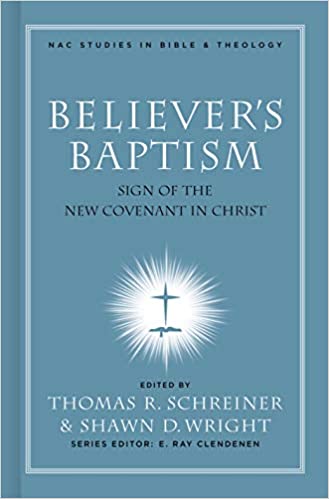A Brief Book Summary from Books At a Glance
By Steve West
Introduction
Believer’s Baptism consists of a collection of essays that address the subject of baptism from a variety of biblical, theological, historical, and practical angles. There is extensive interaction with the arguments of paedobaptists. Each essay is written from a Baptist perspective and argues for believer’s baptism as the biblical practice.
Table of Contents
Introduction
Chapter 1 Baptism in the Gospels – Andreas J. Köstenberger
Chapter 2 Baptism in Luke-Acts – Robert H. Stein
Chapter 3 Baptism in the Epistles: An Initiation Rite for Believers – Thomas R. Schreiner
Chapter 4 Baptism and the Relationship between the Covenants – Stephen J. Wellum
Chapter 5 Baptism in the Patristic Writings – Steven A. McKinion
Chapter 6 “Confessor Baptism”: The Baptismal Doctrine of the Early Anabaptists – Jonathan H. Rainbow
Chapter 7 Baptism and the Logic of Reformed Paedobaptists – Shawn D. Wright
Chapter 8 Meredith Kline on Suzerainity, Circumcision, and Baptism – Duane A. Garrett
Chapter 9 – Baptism in the Stone-Campbell Restoration Movement – A. B. Caneday
Chapter 10 – Baptism in the Context of the Local Church – Mark E. Dever
Summary
Chapter 1: Baptism in the Gospels
Jewish proselyte baptism was an initiatory rite that symbolized purification and entry into a new life. John the Baptist did not baptize Gentiles into Judaism, however, but rather called Jews to a baptism of repentance. His baptism was an ethical one. He was preparing the way for the Lord by calling people to repent. John baptized with water, but Christ baptized with the Spirit.
Mark’s Gospel shows how John’s baptism both fulfills prophecy and prepares for Christ. It also had an element of purification from sin and eschatological entry into God’s true Israel. Jesus used the term baptism in a metaphorical sense to describe his crucifixion. Matthew’s Gospel contains expanded teaching from John the Baptist that Mark’s Gospel lacks (e.g. Jesus is said to be one who will baptize with the Holy Spirit and with fire). John objects to baptizing Jesus, but Jesus says that it is necessary to fulfill all righteousness. Matthew records John’s doubts in prison and his sending of his disciples to speak to Jesus.
A vital Matthean text about baptism is Jesus’ word in the Great Commission. On the basis of Jesus’ authority, the disciples are to go into all the world in order to make disciples, and they are to baptize them in the name of the Trinity. The baptism and teaching of disciples goes together, so the candidates for baptism must be old enough to understand what they are taught.
Luke’s Gospel provides practical teaching from John the Baptist concerning what repentance looks like for various groups. Tax collectors were baptized, but the Pharisees rejected God’s will by refusing. Luke has many of the same baptism pericopes as the other Synoptics, but not all of them. The Gospel of John refers to baptism in three places, including unique material concerning the fact that at one-point, Jesus’ disciples were baptizing people at the same time that John the Baptist’s were.
The Gospels do not refer to baptism very often, and they highlight John’s ministry as one of preparation for the Messiah. In the church age, baptism is for those who have trusted in Christ and turned from their sin, and it is part of discipleship. The best evidence for the mode of baptism points to immersion. Baptism was not understood to have power on its own to regenerate; it was assumed that spiritual regeneration had already taken place.
Chapter 2: Baptism in Luke-Acts
Christian baptism has many similarities with the baptism practiced by John the Baptist, but it also involves the Holy Spirit. Luke does not provide didactic teaching about baptism as much as he describes how it functioned in the early church. Repentance, faith, confession of Christ, baptism, and the gift of the Spirit were connected. It was an initiation rite that attended conversion. Repentance was absolutely necessary for baptism, as was faith.
[To continue reading this summary, please see below....]The remainder of this article is premium content. Become a member to continue reading.
Already have an account? Sign In
